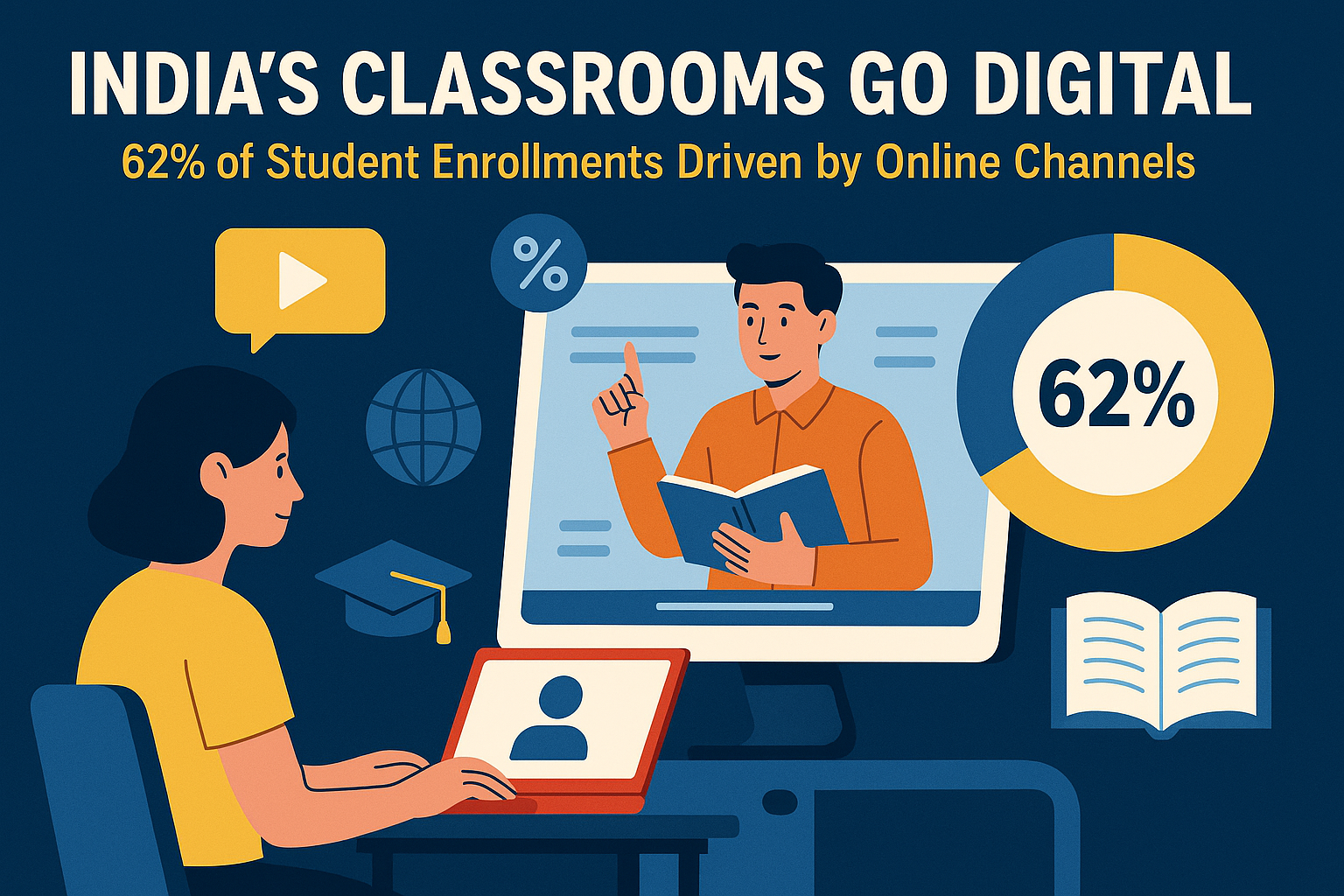
What’s happening
In India, digital channels now account for about 62 % of student enrolments, according to the Meritto Enrollment Index 2025, based on analysis of ~23 million student leads.
The shift signals that schooling and higher-education institutions are increasingly shaped by technology-enabled outreach, applications and learning models.
Key data on the trend
- Digital channels generated 71.78 % of student leads, 77.96 % of paid applications, and 61.55 % of total enrollments.
- Among paid/advertising channels: Google contributed about 10.13 % of enrollments, followed by Shiksha (~3.84 %), CollegeDekho (~3.47 %) and Collegedunia (~1.81 %).
- Traditional offline/off-digital channels still deliver about 38.45 % of enrollments, but their share of leads and applications is shrinking (28.22% of leads, 22.04% of paid apps) in that research. ETEducation.com
Why this matters
- For students & families: The way you discover, apply for and enroll in an institution is increasingly online. That means digital presence, responsiveness, and online experience matter.
- For institutions (schools/colleges/ed-tech): The “funnel” now starts online: brand-visibility, lead-generation, conversion. Institutions must invest in digital marketing, user experience, online admission workflows, and follow-up engagement.
- For equity & access: If enrolment increasingly relies on digital channels, then students without reliable internet access, devices or digital literacy risk being left behind.
- For policy & governance: The digital shift calls for supporting infrastructure (connectivity, devices), teacher training (for digital modes), oversight of online enrolment/admission practices, ensuring transparency and fairness.
Viewing the shift from different perspectives
1. Marketing & Lead-Generation in Education
Institutions are moving from purely offline outreach (school visits, pamphlets, local advertising) to digital funnels: websites, search ads, social media, chatbots, brand-pull online. The report highlights “brandpull” as contributing 26.25 % of enrolments in the digital channel. ETEducation.com
This means that a school/college’s online reputation, user-friendly website, timely responses and digital engagement are becoming competitive differentiators.
2. Student Decision-Making Behaviour
Students (and their families) are increasingly doing their discovery, comparison, application processes online. They are more likely to use smartphones, search engines, platforms, chat options. For instance, one commentary says 55 % of students use smartphones/tablets to explore course offerings. edinbox.com
Therefore the “first impression” digital-touchpoint matters. The online journey—from search → site visit → query response → application → enrolment—is becoming central.
3. Institutional Infrastructure & Operations
With more enrolments coming via digital channels, institutions must examine:
- How well their digital admissions system handles leads and conversions.
- Whether their website, mobile-experience and chat/response system are optimized.
- How they integrate digital data (leads, applications) into institutional workflows (counselling, follow-up).
- Whether offline-to-online hand-offs are smooth (for campus visits, counselling, admissions).
4. Equity, Access & Digital Divide
While digital enrolment is rising, one must ask: Are all students benefiting equally? Rural, remote or economically disadvantaged students may have weaker access to internet, devices, or digital literacy.
If institutions rely heavily on digital-channels, there is a risk of excluding or under-serving segments who are offline or minimally online.
Hence one must watch whether digital enrolment growth correlates with improved access across regions (not just urban/affluent) and whether offline support remains available.
5. Long-Term Implications for Education Delivery
The shift in enrolment source may be a harbinger of broader change: more digital/online delivery, hybrid teaching, more tech-enabled student services, and more data-driven institutional operations.
If enrolment is digital-first, institutions might have to align entire student lifecycle – marketing, admissions, learning, alumni relations – via digital tools. This may change how teaching, campus experience, institutional branding evolve.
What to watch for / What to do
- For students & families: When evaluating institutions, check how responsive they are online (web-visit experience, queries handled, digital information). Also check how compatible they are with digital/hybrid learning (if relevant).
- For institutions: Audit your digital enrolment funnel. What is your website traffic → lead conversion → application → enrolment? Where are drop-offs? How does your brand show online? How are you following up leads digitally? Also consider digital readiness of your operations (CRM, websites, analytics, chatbots).
- For policymakers: Monitor whether digital enrolment growth benefits all regions and demographics. Ensure infrastructure (broadband, devices), digital literacy, and offline options are available so no one is left behind. Also oversight of digital admissions practices (transparency, fairness).
- For ed-tech/marketing firms: There is growing demand for digital-lead-management, analytics, platform-services for institutions. This is a growth area—but institutions will demand evidence of ROI (how many leads convert, how many enroll).
Looking ahead
If this trend continues, by 2027-28 we could see:
- A majority of student enrolments in India initiated fully online, even for schools and colleges that still have significant offline presence.
- Institutions that do not build strong digital enrolment pipelines may struggle to attract students who expect digital-first experiences.
- More blending of digital/online delivery: as enrolment becomes digital, learning delivery may follow – more hybrid/online formats, digital student services, data-driven support.
- But also: Unless digital access is equitable, the digital-divide may widen. Rural, disadvantaged students might lag unless specific policy/ infrastructure support is in place.
Challenges & Risks
- Over-reliance on digital channels may risk neglecting students who are offline or less digitally capable.
- Digital-admissions bring risks: clutter, misinformation, high competition for attention, lead-quality issues, spam-myriad, conversion challenges.
- Institutions may rack up leads but fail to convert or follow-up. Good digital funnel requires process/people not just technology.
- Data-privacy, digital marketing ethics, transparency of admissions must be ensured in digital-first enrolment.
- The quality of online/hybrid learning must match expectations: enrolling students digitally is one thing; delivering quality learning and support is another.



